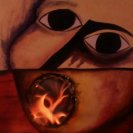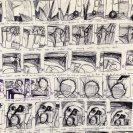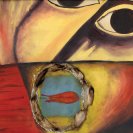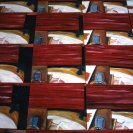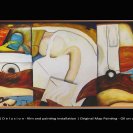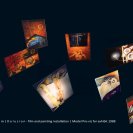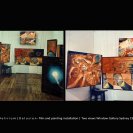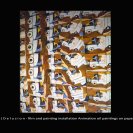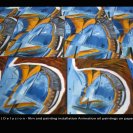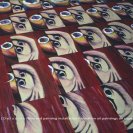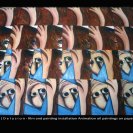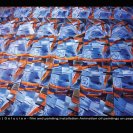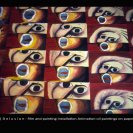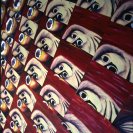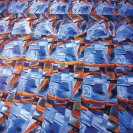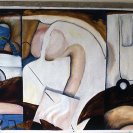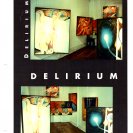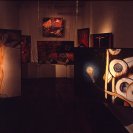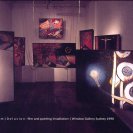Artist statement:
"As I developed and experimented more with the media of painting, sound and animation, I began to see the potential for conveying a metaphysical experience and immersing the viewer in an interactive space. In 1986, I began work on a series of oil painted panels based upon a newspaper article about the death of a group of six people traveling between Darwin and Eliot in the Northern Territory of Australia. I was interested in their progression into a state of psychosomatic delirium, which was brought about by the environment in which they perished. I chose to use installation, animation, and sound to allow the documented event to become an experience for the viewer.
DELIRIUM/Delusion (film and painting installation, 1987-88), the culmination of this concept, was comprised of nine large oil paintings suspended in space with a four-minute animation running on a video loop, and also projected separately on film next door. The viewer could alternate between wandering through the path of the paintings and viewing the film. I painted the entire animation on paper cel with oil paint, as I wanted to achieve a sense of depth and dimension that you can only get through this medium. The image-movement and structure for the film developed out of the original map painting that I created rapidly on separate panels and then re-arranged and photographed to form different narratives and sequences. This then became the image-movement for the film. I created the soundtrack through interviewing people about the event and using excerpts of their conversation, blended with sound effects, to further enhance the disturbance of the space.
Through the direct physical expression of painting and drawing it is possible to capture what James McGaugh calls the “emotional over expression, which lies at the basis of disorder” [1]. Images represent emotional experiences that move us in a powerful and visceral way. Although an entire symbolic narrative exists in one painting alone, this landscape is not always adequately represented in a linear cause-and-effect mode, and perhaps this is why the best starting point to map intense experiences is to add the elements of sound and movement to static images.
When reason is overpowered by emotion, or the environment is affecting our physiological state, our perception of the moment is intensified through our physical senses. The brain receives and burns these intense experiences into memories that later can cause sounds, images, color, and movement to invoke the same, what Richard Restak characterizes as ”disorganizing emotional components” [2]. Animation and sound can unfold and re-connect these images, turning the event into an experience.This exhibition and body of work set the foundation for my future research in spatial Dolby digital sound, three dimensional animation, and interactive environments."
Sources:
1. Quote by James McGaugh University of California at Irvine used by Richard Restak M.D. To Think by Feeling, The Adult Brain - The Secret Life of the Brain 2001 A co-publication of the Dana Press and the Joseph Henry Press) p. 130
2. Restak, Richard M.D. To Think by Feeling, The Adult Brain - The Secret Life of the Brain (2001 A co-publication of the Dana Press and the Joseph Henry Press) p. 130
DELIRIUM/Delusion was exhibited at SACI, Florence Italy in 1988, and at Window Gallery, Sydney in 1990. The animated film DELIRIUM went on to be exhibited at film festivals, screened on Eat Carpet SBS television, returning to Italy in 1995 to be exhibited at the Conservatorio di Santa Maria degli Angeli, Florence. It was nominated for Best Experimental Film at the 1988 Australian Film Institute Awards.
